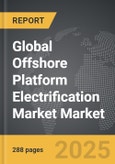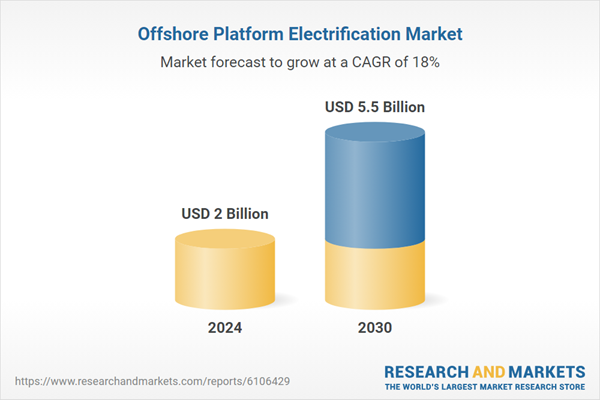Global Offshore Platform Electrification Market - Key Trends & Drivers Summarized
Why Is Electrification Gaining Ground in Offshore Platform Operations?
Electrification of offshore platforms is gaining momentum as operators seek to reduce carbon emissions, improve energy efficiency, and align with climate commitments. Traditionally, offshore oil and gas platforms have relied on gas turbines and diesel generators for power, which contribute to high levels of greenhouse gas emissions. Electrification, especially through connection to onshore power grids or offshore wind sources, is enabling operators to decarbonize platform operations while ensuring consistent energy supply. This shift is part of a broader move toward sustainable offshore asset management.Government pressure to reduce offshore emissions is prompting oil and gas producers to consider full or partial electrification of platform utilities. In some regions, such as the North Sea and Norwegian Continental Shelf, grid-based electrification is already being implemented in large-scale projects. Elsewhere, hybrid solutions combining wind, solar, and battery systems are under evaluation for remote or floating installations. These transitions reflect growing interest in integrating renewable power systems into offshore environments previously dominated by fossil fuel-based power sources.
What Infrastructure and Technology Are Enabling Offshore Electrification?
Implementing offshore electrification requires specialized subsea power transmission systems, high-voltage cables, and platform-level electrical distribution upgrades. Subsea cable technology is advancing to allow longer distances, deeper water operation, and higher power transmission without significant losses. Integration of HVAC and HVDC systems is helping extend power delivery to platforms located far from shore. On-platform modifications include replacement of gas turbines with electric motors, switchgear upgrades, and addition of power management systems capable of handling grid fluctuations.Electrification projects also rely on advanced control systems and remote monitoring to ensure stability and efficiency in power usage. Energy storage systems, including marine-grade lithium-ion batteries, are being deployed to address intermittent power issues and balance load demands. In offshore wind-powered platforms, smart energy management software is enabling synchronization between turbine output and platform requirements. These technologies are reducing operational emissions while enhancing long-term energy security for offshore assets.
Where Are Electrification Projects Being Deployed and Expanded?
Offshore platform electrification is being prioritized in regions with strong regulatory frameworks and accessible power infrastructure. North Sea operators are leading this transition, supported by national decarbonization strategies and established grid connections. Norwegian projects, in particular, are setting benchmarks in grid-tied platform operations. Interest is also growing in electrification of platforms in the Gulf of Mexico, offshore Brazil, and Southeast Asia, where emission reduction targets are becoming more defined.Floating platforms, FPSOs, and remote installations are exploring hybrid electrification models involving wind turbines, wave energy systems, and solar arrays. In these areas, grid connections may be unfeasible, making standalone or microgrid power systems more practical. Industry collaborations are forming to test integrated offshore energy hubs, combining oil production, wind power, and hydrogen generation in a shared infrastructure. These initiatives are accelerating deployment of electrified systems across a diverse range of offshore asset types.
Growth in the Offshore Platform Electrification market is driven by several factors…
Growth in the offshore platform electrification market is driven by multiple technology and policy-related factors. Increasing pressure to decarbonize offshore operations is prompting operators to replace gas turbines with electric drive systems. Government regulations mandating carbon intensity reductions are encouraging adoption of grid-connected and renewable-powered electrification. Advancements in subsea power cable technology, including higher-voltage and longer-distance transmission, are expanding electrification feasibility for remote platforms.Deployment of floating wind farms and offshore renewable hubs is creating synergies between oil production and clean energy generation, supporting hybrid electrification models. On-platform upgrades in control systems, power distribution, and storage technologies are enabling seamless integration of electric power into existing infrastructure. Investment in electrification projects is also supported by the long-term operational savings and emission credits they offer. Together, these factors are reinforcing steady growth in offshore platform electrification across both mature and emerging offshore basins.
Report Scope
The report analyzes the Offshore Platform Electrification market, presented in terms of market value (US$). The analysis covers the key segments and geographic regions outlined below:- Segments: Technology (Offshore Wind Technology, Underground Cable Technology, Turbine Technology); Application (Production Platforms Application, Drilling Rigs Application, Floating Production Storage & Offloading Units Application, Other Applications).
- Geographic Regions/Countries: World; United States; Canada; Japan; China; Europe (France; Germany; Italy; United Kingdom; Spain; Russia; and Rest of Europe); Asia-Pacific (Australia; India; South Korea; and Rest of Asia-Pacific); Latin America (Argentina; Brazil; Mexico; and Rest of Latin America); Middle East (Iran; Israel; Saudi Arabia; United Arab Emirates; and Rest of Middle East); and Africa.
Key Insights:
- Market Growth: Understand the significant growth trajectory of the Offshore Wind Technology segment, which is expected to reach US$3 Billion by 2030 with a CAGR of a 16.9%. The Underground Cable Technology segment is also set to grow at 19% CAGR over the analysis period.
- Regional Analysis: Gain insights into the U.S. market, valued at $557.8 Million in 2024, and China, forecasted to grow at an impressive 23.5% CAGR to reach $1.2 Billion by 2030. Discover growth trends in other key regions, including Japan, Canada, Germany, and the Asia-Pacific.
Why You Should Buy This Report:
- Detailed Market Analysis: Access a thorough analysis of the Global Offshore Platform Electrification Market, covering all major geographic regions and market segments.
- Competitive Insights: Get an overview of the competitive landscape, including the market presence of major players across different geographies.
- Future Trends and Drivers: Understand the key trends and drivers shaping the future of the Global Offshore Platform Electrification Market.
- Actionable Insights: Benefit from actionable insights that can help you identify new revenue opportunities and make strategic business decisions.
Key Questions Answered:
- How is the Global Offshore Platform Electrification Market expected to evolve by 2030?
- What are the main drivers and restraints affecting the market?
- Which market segments will grow the most over the forecast period?
- How will market shares for different regions and segments change by 2030?
- Who are the leading players in the market, and what are their prospects?
Report Features:
- Comprehensive Market Data: Independent analysis of annual sales and market forecasts in US$ Million from 2024 to 2030.
- In-Depth Regional Analysis: Detailed insights into key markets, including the U.S., China, Japan, Canada, Europe, Asia-Pacific, Latin America, Middle East, and Africa.
- Company Profiles: Coverage of players such as Abbott Laboratories, ACM Global Laboratories, ARUP Laboratories, BioReference Laboratories, Cleveland Clinic Laboratories and more.
- Complimentary Updates: Receive free report updates for one year to keep you informed of the latest market developments.
Some of the 48 companies featured in this Offshore Platform Electrification market report include:
- ABB Ltd
- Aker Solutions
- BP p.l.c.
- Cerulean Winds Ltd.
- Eaton Corporation PLC
- Equinor ASA
- GE Vernova (GE Renewable)
- Honeywell International Inc.
- Husfram (Havfram)
- Mitsubishi Electric
- NKT A/S
- Nexans
- Ørsted
- Petrofac
- Prysmian Group
- Siemens Energy
- SLB (Schlumberger)
- Subsea7 (OneSubsea JV)
- TechnipFMC
- Wärtsilä
This edition integrates the latest global trade and economic shifts into comprehensive market analysis. Key updates include:
- Tariff and Trade Impact: Insights into global tariff negotiations across 180+ countries, with analysis of supply chain turbulence, sourcing disruptions, and geographic realignment. Special focus on 2025 as a pivotal year for trade tensions, including updated perspectives on the Trump-era tariffs.
- Adjusted Forecasts and Analytics: Revised global and regional market forecasts through 2030, incorporating tariff effects, economic uncertainty, and structural changes in globalization. Includes historical analysis from 2015 to 2023.
- Strategic Market Dynamics: Evaluation of revised market prospects, regional outlooks, and key economic indicators such as population and urbanization trends.
- Innovation & Technology Trends: Latest developments in product and process innovation, emerging technologies, and key industry drivers shaping the competitive landscape.
- Competitive Intelligence: Updated global market share estimates for 2025, competitive positioning of major players (Strong/Active/Niche/Trivial), and refined focus on leading global brands and core players.
- Expert Insight & Commentary: Strategic analysis from economists, trade experts, and domain specialists to contextualize market shifts and identify emerging opportunities.
Table of Contents
Companies Mentioned (Partial List)
A selection of companies mentioned in this report includes, but is not limited to:
- ABB Ltd
- Aker Solutions
- BP p.l.c.
- Cerulean Winds Ltd.
- Eaton Corporation PLC
- Equinor ASA
- GE Vernova (GE Renewable)
- Honeywell International Inc.
- Husfram (Havfram)
- Mitsubishi Electric
- NKT A/S
- Nexans
- Ørsted
- Petrofac
- Prysmian Group
- Siemens Energy
- SLB (Schlumberger)
- Subsea7 (OneSubsea JV)
- TechnipFMC
- Wärtsilä
Table Information
| Report Attribute | Details |
|---|---|
| No. of Pages | 288 |
| Published | December 2025 |
| Forecast Period | 2024 - 2030 |
| Estimated Market Value ( USD | $ 2 Billion |
| Forecasted Market Value ( USD | $ 5.5 Billion |
| Compound Annual Growth Rate | 18.0% |
| Regions Covered | Global |









